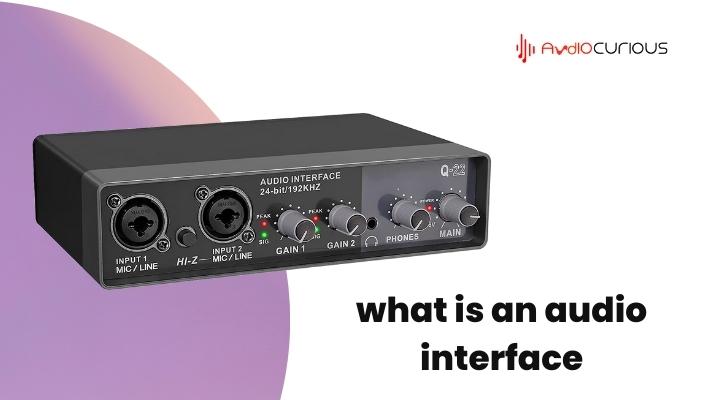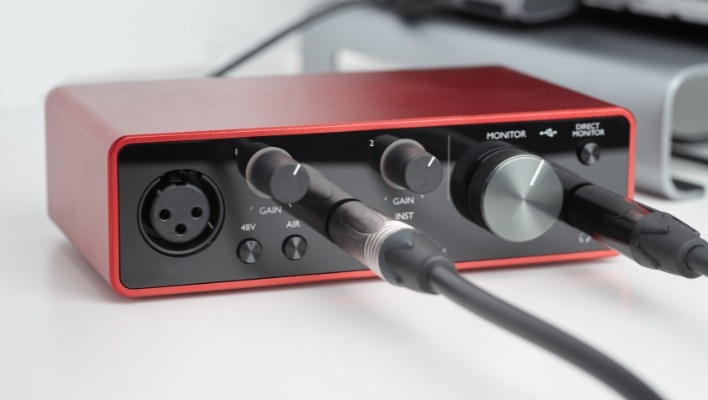If you’re a musician or audio enthusiast, you’ve likely heard the term “audio interface” before. But what exactly is an audio interface, and do you need one for your music production setup? In this article, we’ll dive into the world of audio interfaces and explore the various types, features, and benefits they offer. We’ll help you understand whether an audio interface suits you and your music production needs, from USB and USB-C options to digital interfaces for guitars and other instruments.
What is an Audio Interface?
An audio interface is a hardware device that connects your microphone, instrument, or other audio sources to your computer or recording equipment. It acts as the middleman between your audio source and your recording software, allowing you to capture high-quality audio recordings.
Audio interfaces come with various features and capabilities, including inputs and outputs for connecting your audio sources, preamps for boosting the signal from your microphone or instrument, and built-in effects processing for shaping your sound. Some audio interface inputs offer additional features, such as phantom power for condenser microphones and zero-latency monitoring for recording and performing live. Several audio interfaces are available, including USB, USB-C, and digital.

USB Audio Interfaces
These are a great choice for musicians who need an easy way to record and playback audio. They are relatively inexpensive and usually powered by a computer’s USB port. USB audio interfaces typically have multiple inputs and outputs for analog and digital signals, allowing them to work with various audio sources, such as microphones, keyboards, and guitars. The interface also provides a direct connection to the computer, which can be used for digital audio recording and playback.
USB-C Audio Interfaces
USB-C audio interfaces are the latest in audio interface technology. They are much more powerful than USB audio interfaces and offer a variety of features. USB-C audio interfaces are capable of handling high-resolution audio and typically have more inputs and outputs than USB audio interfaces. They also offer additional features such as digital signal processing and low latency performance. USB-C audio interfaces can also send and receive audio over USB-C, making them an ideal choice for musicians who need to connect multiple audio sources.

Digital Audio Interfaces
These are the most advanced type of audio interface available. Professional recording studios and audio engineers typically use them. Digital audio interfaces can handle high-resolution audio and provide various features, including digital signal processing and low latency performance. They also offer a variety of inputs and outputs, allowing them to connect to various analog and digital audio sources. Digital audio interfaces are usually more expensive than USB and USB-C audio interfaces, but they are ideal for professional recording and audio engineering applications.
Do I need an Audio Interface?
Whether or not you need an audio interface for your music production setup depends on your individual needs and goals. Here are some reasons why someone might need an audio interface:
To Improve Sound Quality
If you’re recording with a low-quality built-in sound card or using a microphone with a low-quality preamp, an audio interface can significantly improve the sound quality of your recordings. Audio interfaces typically have high-quality preamps and built-in effects processing, allowing you to capture clean, detailed recordings.
To Connect Multiple Instruments
If you want to record multiple instruments simultaneously, an audio interface with multiple inputs can make connecting and recording multiple sources easier.
To Record Multiple Tracks Simultaneously
If you want to record multiple tracks simultaneously, an audio interface with multiple outputs can make it easier to route each track to a separate recording channel in your DAW software.
While an audio interface can be beneficial for these reasons, there are alternatives to using one. For example, you can use a built-in sound card on your computer if you’re on a tight budget or only need to record a single instrument simultaneously. You can also use a digital audio workstation (DAW) software with built-in effects processing and routing capabilities, eliminating the need for an external audio interface.
When deciding whether to purchase an audio interface, there are several factors to consider, such as your budget, intended use, and compatibility with other equipment. It’s essential to research and compare different audio interfaces to find the one that best meets your needs and fits within your budget. You should also consider the compatibility of the audio interface with your computer and other equipment, such as microphones and instruments.

Audio Interface for Mac and PC
Audio interfaces are typically compatible with Mac and PC operating systems, making them easy to use with any computer. However, there may be some differences between Mac and PC audio interfaces, such as available features and compatibility with specific software.
For example, some audio interfaces may have features that are only available on Mac or PC. For example, a Mac audio interface may include built-in support for Apple’s Core Audio technology. In contrast, a PC audio interface may support ASIO (Audio Stream Input/Output) or WASAPI (Windows Audio Session API). Additionally, some audio interfaces may be compatible with specific software only available on Mac or PC.
When choosing an audio interface for your Mac or PC, it’s important to research and compare different options to find the one that offers the features and compatibility you need. It’s also a good idea to check the compatibility of the audio interface with your specific operating system and software to ensure it will work seamlessly with your setup.
Audio Interface for Guitar
Guitar audio interfaces are specialized audio interfaces designed specifically for recording and performing with guitars and other instruments. These audio interfaces often include features tailored to musicians’ needs, such as built-in preamps and effects processing.
Guitar audio interfaces typically offer a range of inputs and outputs for connecting your guitar and other instruments, as well as built-in preamps for boosting the signal from your guitar. Some guitar audio interfaces include built-in effects processing, such as reverb, delay, and distortion, allowing you to shape your sound without needing external pedals or effects processors.
When choosing the best audio interface for guitars, you must consider your intended use and budget. If you’re a professional musician looking to record high-quality recordings, you may want to invest in a high-end guitar audio interface with advanced features and capabilities.
If you’re a beginner or casual musician looking to record at home, a more affordable guitar audio interface with basic features may be sufficient. It’s also a good idea to research and compare different guitar audio interfaces to find the one that best meets your needs and fits within your budget.
Conclusion
In conclusion, an audio interface is a valuable piece of equipment for musicians and audio enthusiasts. It allows you to connect your audio sources to your computer or recording equipment and capture high-quality recordings. Whether you need an audio interface depends on your individual needs and goals, but it can be a valuable investment for improving sound quality, connecting multiple instruments, and recording multiple tracks simultaneously.
Audio interfaces are available for Mac and PC operating systems. There are also specialized audio interfaces for guitars and other instruments. When choosing an audio interface, it’s important to consider several factors, including your intended use, budget, and compatibility with other equipment.


Very informative and good bodily structure of content material, now that’s user genial (:.